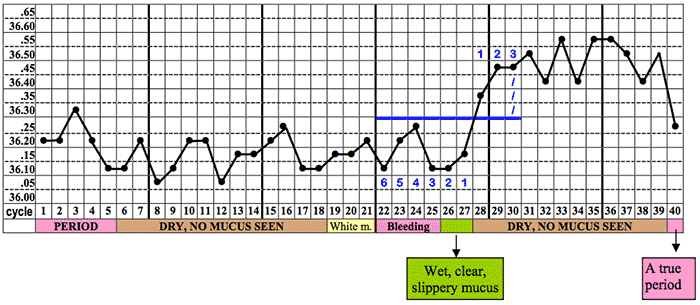guidelines to charting your fertility cycle, page 9 of 26
1. The Temperature Method - A Cycle without a Temperature Rise:
If, by any chance, a cycle occurs without a temperature shift in it, then it is not a true cycle and great care must be taken in applying the rules. There are two possible explanations for this “cycle”.
- It may be a genuine anovulatory cycle (i.e. a cycle without ovulation), and the next cycle after it may be the same or a completely normal cycle.
- However, it could also be a “stress cycle” with delayed ovulation, which can have a different result and this type of cycle needs to be watched carefully.
Below is a typical example of the “stress type” cycle.
The cycle started normally with a period but no mucus pattern developed. This person normally had a fairly typical cycle between 27 - 30 days in length. Normally she would expect to ovulate around days 13 - 17, but they came and went with no fertile type mucus evident at all.
Then Days 19 - 21 showed a white creamy mucus, leading her to think ovulation was approaching, only to be followed by bleeding - much to her surprise! In some cases the bleeding is very light, but occasionally, as in this example, it was heavy enough for her to think it was a period. Notice the temperature remained at the same level up to this point (Day 22).

Fortunately, she contacted an NFP teacher, who was able to advise her appropriately.
She was told NOT to start a new chart as the bleeding on Days 22 - 25 was NOT a true period. She must simply wait and see what followed. As suspected, the bleeding led immediately into classic fertile raw egg-white type mucus, ovulation occurred and the temperature rose. 13 days later, her TRUE period came. So in fact, it ended as a 39 day cycle, with “ovulation bleed” occurring on days 22 - 25.
The problem with these cycles is that for those who are not monitoring their cycle, they would have assumed Days 22 - 25 were an early period. As many people do, they would also have assumed they were infertile after it for a couple of days - which was far from the case! The bleeding led into the most fertile time of the whole 39 day cycle. You can see how a surprise pregnancy would occur, and to many, it would seem absolutely inexplicable! It’s only when people are well informed on NFP charting and actually document their cycles that explanations become available.
such cycles can be caused by ‘flu and other illness, and also by stress situations, such as baby very ill, mum or dad in hospital, final exams, job interviews, moving house etc. sometimes cycles can stop completely for weeks / months even, in cases of acute stress! many such cycles can occur in the pre-menopause years before they finally stop. please note this cycle & rules
- Previous |
- Next |
- Exit Tutorial |
- Help |
- Download as a PDF
© 2011 Fertility Education & Training